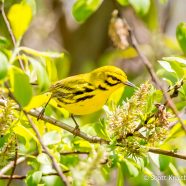Chestnut-sided Warbler
The Chestnut-sided Warbler (Setophaga pensylvanica) is one of the most unique of our warblers in terms of appearance, though this bird is not quite showing all of that chestnut, black or bold yellow yet. It is likely a first spring male that was still coming into his plumage in early May. He was very friendly and cooperative for both photos and prolonged binocular views, allowing a group of birders to enjoy him posing while foraging without the use of any pishing or song playbacks. In my experience the best tactic for spring migratory birding is often just to move slowly, be quiet and...
Read MorePrairie Warbler
This male Prairie Warbler (Setophaga discolor) put on a sensational display for us last Sunday all while singing away and finding plenty to eat after his journey the previous night. It took a few hours to finally see the bird after hearing the rising, buzzy song repeatedly in the morning. The sun was shining brightly high in the sky by the time he came out into the open, giving the yellow warbler an even brighter glow while foraging in these willows. The Prairie Warbler is one of those species that perplexes me in the Chautauqua-Allegheny region. I feel like there should be more of them in...
Read MoreBlack-and-white Warbler
I finally took some good photos of Black-and-white Warblers (Mniotilta varia) over the last few days as the species is peaking as a migrant in the Northeast. These stunning little birds never stop moving…and they move like a nuthatch, creeping and crawling along branches, vines and tree trunks for various insects and spiders. This nonstop motion makes them a difficult clean capture as their photos often end up a little blurry. At least this guy – while still not paying me any attention – paused for a moment or two while searching for prey on Sunday morning. I found an even...
Read MoreBlue-winged Warbler
This is another photo that I captured yesterday morning with a semi-friendly Blue-winged Warbler (Vermivora cyanoptera) taking a glance at me before he moved on. Can you identify the bird in the background? I intentionally did not crop this photo very much because I liked seeing the adult male Orchard Oriole (Icterus spurius) chowing down not much further up the trail from the warbler. I saw plenty of both Orchard and Baltimore Orioles yesterday, but none of them were very friendly for the camera. I’ll get you, orioles… Scott Kruitbosch Conservation & Outreach...
Read MoreLeucistic Yellow-rumped Warbler
Here is that unique Yellow-rumped Warbler which I mentioned in a previous post. Can you see what looks different about it? I noticed it naked eye while tracking various subjects in a loose flock through the trees last week including more Yellow-rumps, Black-and-white Warblers, Blue-headed Vireos, and Blue-gray Gnatcatchers. After I got my binoculars on it I realized this bird was partially leucistic, and I quickly raised my camera to snap off a record photo. Leucism in birds is when melanin pigments are produced at less than normal levels or in an unexpected pattern. In this case many of the...
Read More








